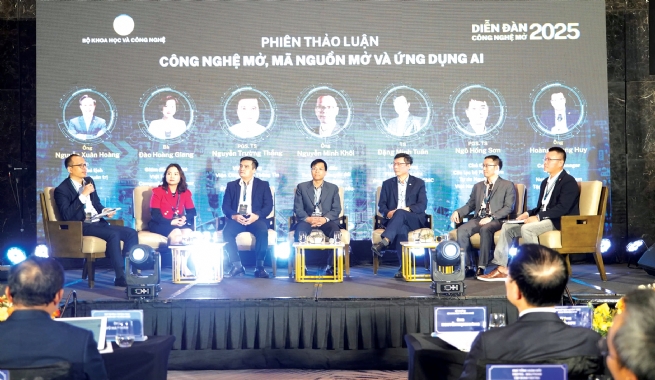10:13:47 AM | 11/25/2025
At the Vietnam Open Summit 2025, Minister of Science and Technology Nguyen Manh Hung emphasized that digital technology is the “breath of the new era” and must be accessible to all. He warned that relying on expensive foreign “black box” technologies risks losing control over important infrastructure and constrains the country’s creativity and technological independence.

Open technology, open source and AI applications panel session
Following global trends, many countries now choose open technology instead of closed solutions, and Vietnam is taking a similar approach. This strategy relies on open-source platforms, open architecture, and open standards, while fostering a culture of open innovation in the community. The goal is to turn Vietnamese users from passive consumers into active creators who manage their digital future at minimal cost.
Minister Nguyen Manh Hung stressed that the open philosophy can only be effective if supported by robust, autonomous physical infrastructure. This foundation allows Vietnam to leverage global knowledge while creating a new level of innovation where “the greatest creativity is the creativity of the entire people,” ensuring technological independence and maximizing benefits in the digital era.
Three pillars for Vietnamese AI ecosyst
To put the open technology philosophy into practice, Vietnam faces a strategic choice: either continue depending on closed, monopolized technology ecosystems or pursue autonomy through open AI. According to Dr. Vu Hai Quan, Deputy Minister of Science and Technology, AI has evolved beyond a mere application tool to become a “national intelligence infrastructure,” similar in importance to electricity, roads, or the internet.
Experts proposed three strategic pillars to build a self-reliant Vietnamese AI ecosystem. The first pillar is national computing infrastructure, the “physical backbone” of artificial intelligence. Generative AI requires massive computing power, making the development of high-performance “Make in Vietnam” data centers and computing clusters essential to reduce dependence on expensive foreign solutions.
The second pillar is open data platforms, considered the “lifeblood” that nourishes AI models. A key challenge is building a standardized national data repository, especially for Vietnamese-language data. Mastering this resource allows AI to “speak our language, understand our culture,” and serve citizens efficiently at low cost.
The final pillar is an open AI community, or the nation’s “collective brain.” This connects scientists, engineers, and businesses to contribute knowledge and reduce duplicated research costs. Operating a nationwide open system, however, presents practical challenges in security and investment efficiency, which remain urgent issues for companies and regulators to address.
Applying open technology in practice
While the national strategy for widespread technology adoption is clear, implementing open AI in businesses requires balancing affordability and accessibility with safety and sustainability. Technology companies recognize that developing open AI must include strict security standards. A representative from Palo Alto Networks Vietnam highlighted four key risk areas any open AI system faces: data and privacy, cybersecurity, system errors, and supply chain vulnerabilities. Consequently, developing AI standards for Vietnam must address these risks and align quickly with emerging international norms.
Beyond security, a major challenge is the high initial infrastructure cost. Nguyen Di An from Quantum Vietnam compared data to “crude oil” and AI systems to “refineries.” Building and operating these “refineries” is expensive, making infrastructure optimization essential to lower the cost of end products.
Open technology plays an important role in overcoming these cost barriers. It is not only an ethical choice but also an economic solution, optimizing costs and energy use while providing a foundation for transparent AI systems.
Dr. Ngo Hong Son, Chairman of the Vietnam Free and Open Source Software Association (VFOSSA), stressed that the top priority is building infrastructure. With a strong infrastructure foundation, other components such as new models and applications can develop naturally, ensuring Vietnamese AI “advances far and correctly.”
Beyond technical and cost challenges, Vietnam has outlined a long-term roadmap to make open technology a tool for shaping the future. The year 2026 marks a key milestone when the national action program for developing an open community, focused on open AI, will officially launch to build a sustainable innovation ecosystem with distinctly Vietnamese characteristics.
Implementing this roadmap requires a three-way cooperation mechanism. According to Minister Nguyen Manh Hung, the government will lead by using open source in digital governance, building a national AI supercomputing center, developing open data centers, and commissioning open AI projects. Businesses will develop open platforms, while universities and research institutes will nurture the open community. Every participant is expected to take responsibility and commit to action.
Dr. Vu Hai Quan summarized that if in 1945 Vietnam affirmed that “Nothing is more precious than independence and freedom,” then in 2025, in the era of artificial intelligence, this principle continues as “Nothing is more important than digital sovereignty.” Developing open AI is the only way to safeguard digital sovereignty while ensuring all citizens have equal access to technology, guiding the nation toward strength and prosperity by 2045.
By Huong Ly, Vietnam Business Forum